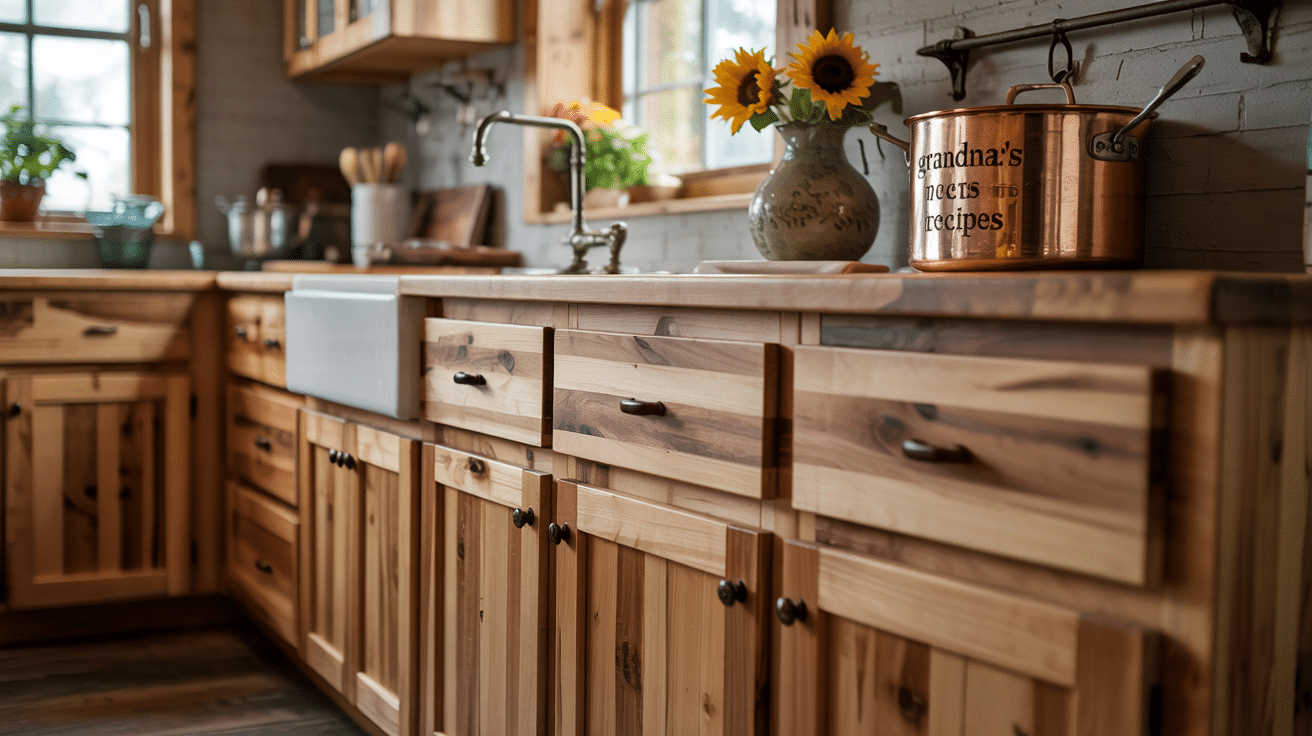Selecting the right wood for your kitchen cabinets is one of the most important decisions you’ll make during a kitchen renovation.
The type of wood you choose affects not only how your kitchen looks but also how well it functions and how long your cabinets will last.
No matter if you’re planning a complete kitchen overhaul or simply updating existing cabinetry, understanding the pros and cons of different wood types will help you make an informed choice that balances your budget.
In this guide, we’ll examine the most popular cabinet wood options, comparing their costs, strengths, limitations, and ideal applications for your next kitchen project. Lets jump in!
List of Top-Picked Cabinet Wood Types with Pros and Cons
Firstly let’s dive into a detailed list of the top-pick cabinet wood types, along with their pros and cons to help you make the best choice for your kitchen or bathroom.”
1. Oak
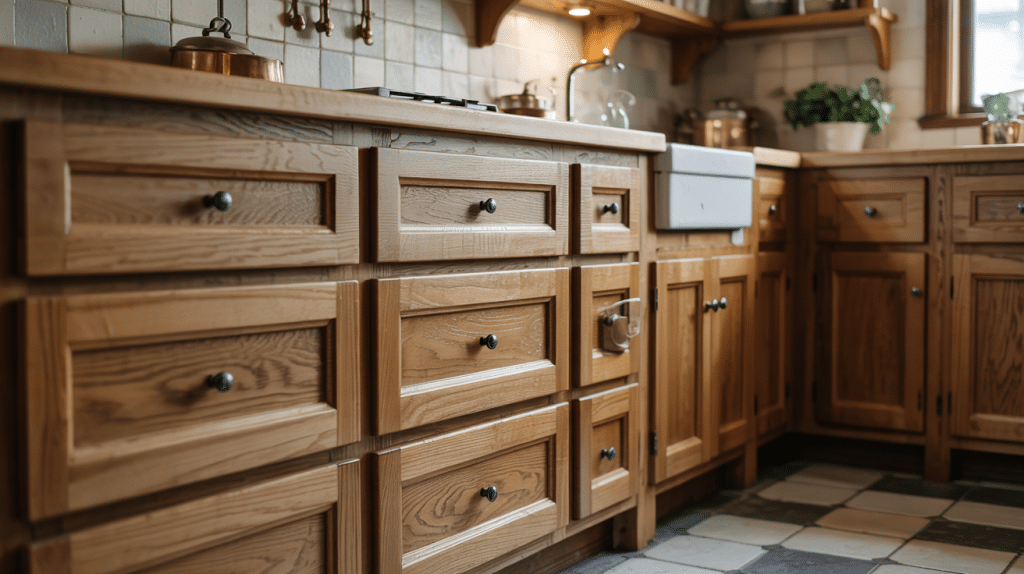
Oak is a classic and sturdy hardwood, known for its strength and versatility. It has a distinctive grain pattern, making it ideal for traditional and rustic designs.
It takes stains well, and over time, it develops a beautiful patina, making it a favorite in kitchens and bathrooms.
Oak is available in two varieties: red and white oak, with white oak being more durable and resistant to moisture.
Cost: $3 – $10 per square foot
Best Suited For:
High-traffic areas, traditional or rustic kitchen designs, and cabinets that need to withstand daily use.
| Pros | Cons |
|---|---|
| Extremely durable and strong | Can be difficult to work with due to its density |
| Works well with stains and finishes | Oak’s grain can be too bold for some modern designs |
| Classic appeal for traditional kitchens | The grain can make it harder to get smooth finishes |
2. Maple
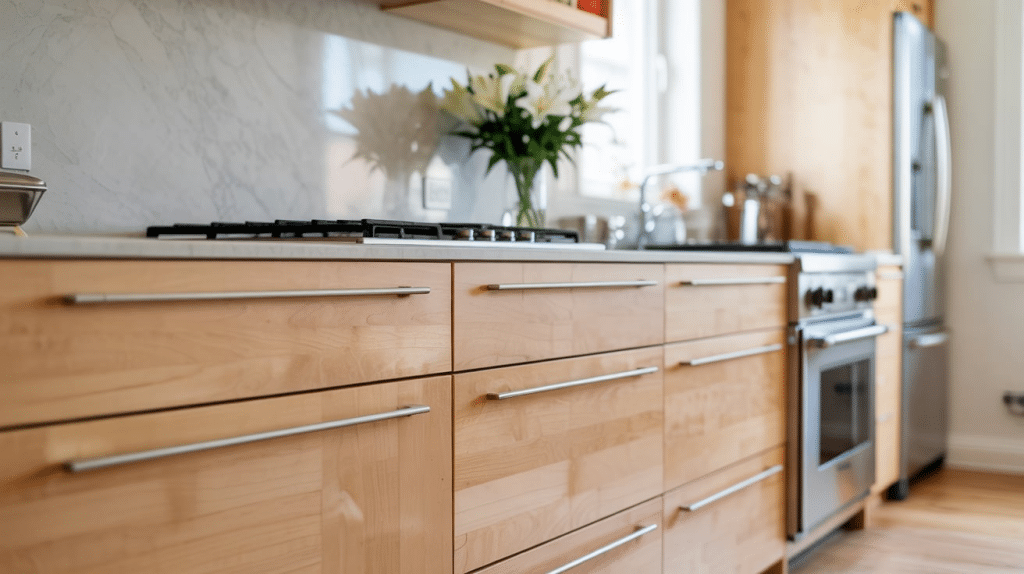
Maple is a smooth-textured, pale-colored hardwood that’s known for its durability. It’s highly resistant to scratches, making it a solid choice for cabinets that need to endure daily use.
The wood’s natural light color can be easily stained, making it versatile for various styles, especially modern and contemporary kitchens.
Cost: $4 – $12 per square foot
Best Suited For:
Modern or contemporary kitchen designs and cabinets that will be painted or stained.
| Pros | Cons |
|---|---|
| Very durable and resistant to wear | Can show scratches more easily due to its smooth surface |
| Versatile for different stains and paints | Less visually appealing in its natural state compared to other woods |
| Works well for a modern, clean look | More expensive than some other common hardwoods |
3. Cherry

Cherry wood is a high-end, elegant hardwood known for its rich, reddish-brown color that deepens with age. It’s smooth, durable, and often used in high-end custom cabinetry.
The wood’s unique color gives it a luxurious look, making it popular for both traditional and contemporary kitchens.
Cost: $6 – $15 per square foot
Best Suited For:
Luxury kitchen cabinets, traditional and contemporary designs, and projects where the natural beauty of the wood is a focal point.
| Pros | Cons |
|---|---|
| Rich color that improves with age | Very expensive compared to other hardwoods |
| Extremely durable and strong | Soft wood that can be susceptible to dents |
| Elegant, high-end appeal | Can be affected by sunlight, fading over time |
4. Hickory
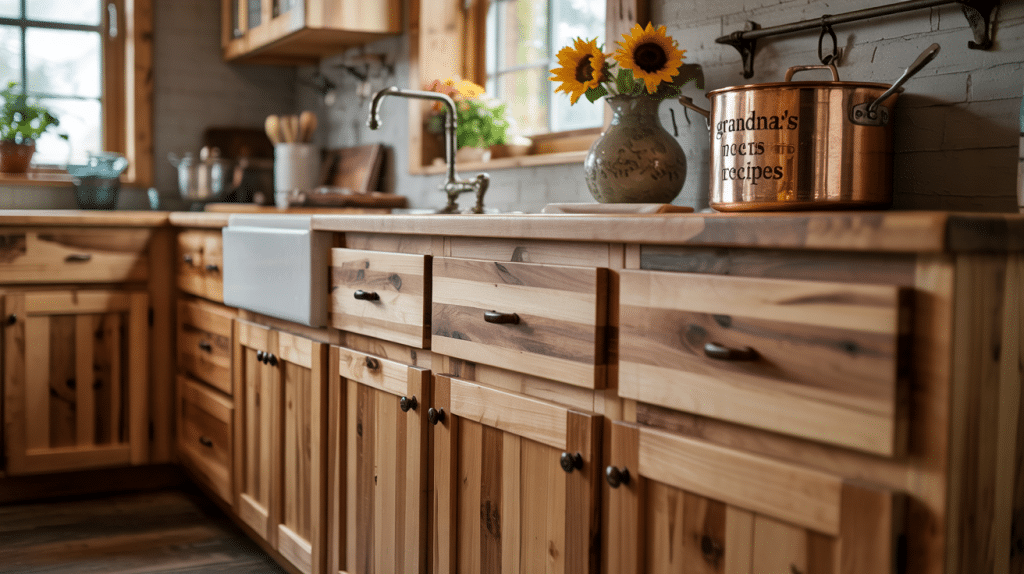
Hickory is a dense and heavy wood known for its bold grain patterns and contrasting color. It’s one of the strongest hardwoods available, making it an excellent choice for heavy-use areas.
Hickory’s natural color variation can range from light to dark, providing a rustic, bold look.
Cost: $5 – $10 per square foot
Best Suited For:
Rustic kitchens, cabinetry in high-use areas, and homeowners looking for a distinctive, bold grain pattern.
| Pros | Cons |
|---|---|
| Extremely durable and strong | Difficult to work with due to its density |
| Great for rustic and country-style kitchens | The grain can be very bold, which some may find too overwhelming |
| Beautiful color variations | Very heavy, making installation more challenging |
5. Birch
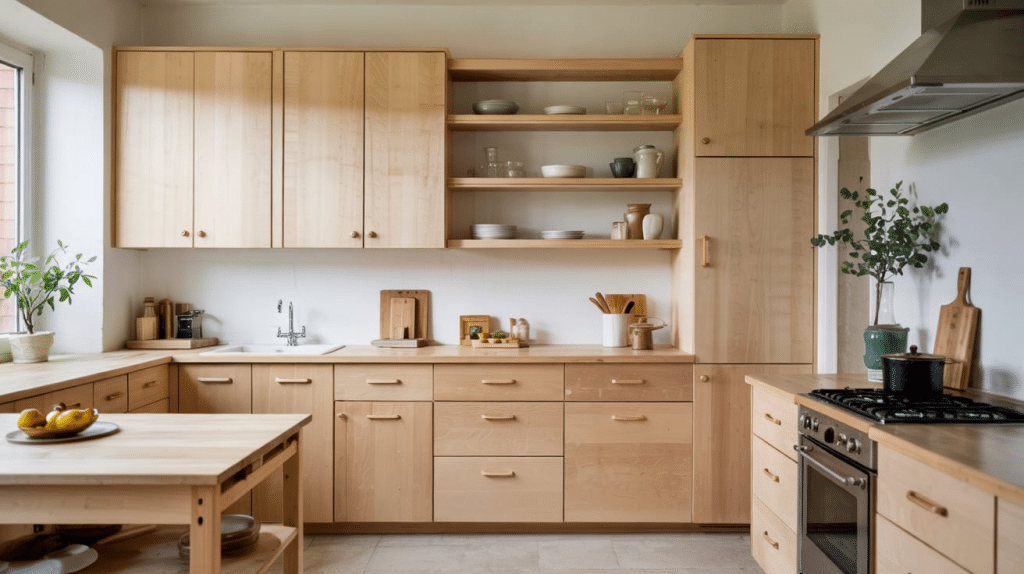
Birch is a fine-grained, light-colored hardwood that’s known for its smooth texture. It’s affordable compared to other hardwoods and offers a clean, consistent look.
Birch is also durable but can be prone to imperfections, such as knots, which gives it a bit of character.
Cost: $4 – $9 per square foot
Best Suited For:
Custom or semi-custom cabinetry, budget-friendly designs, and kitchens needing a smooth, light-colored wood.
| Pros | Cons |
|---|---|
| Affordable and durable | Can have visible knots and imperfections |
| Smooth texture that works well with stains | Lighter color may not suit everyone |
| Takes stains and paints well | Not as visually striking as other hardwoods |
6. Pine
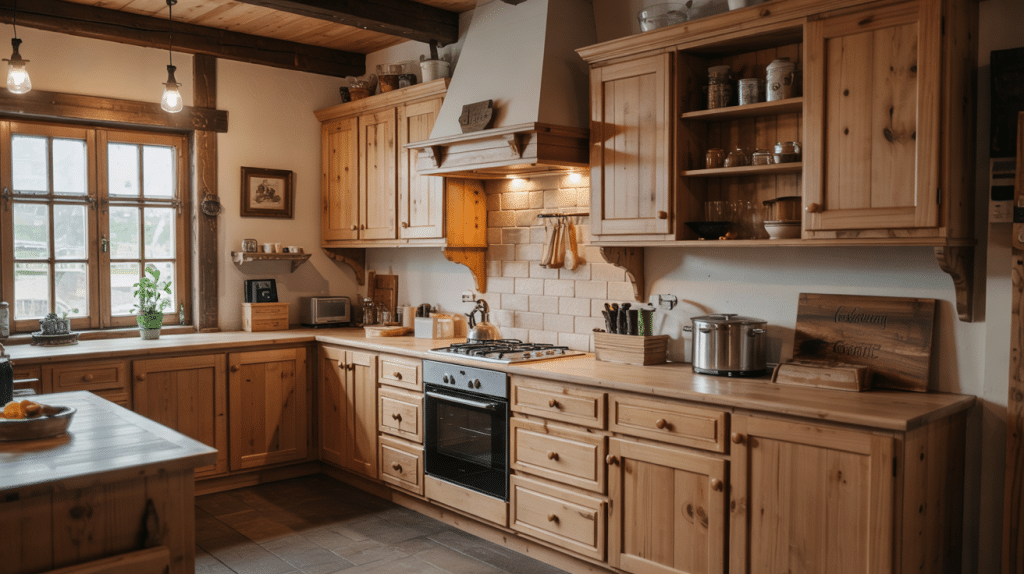
Pine is a softwood that’s known for being lightweight, affordable, and easy to work with. It has a light color and is often used in rustic or traditional designs.
Pine is soft compared to hardwoods, meaning it’s not as durable, but it’s still great for budget-friendly projects.
Cost: $2 – $6 per square foot
Best Suited For:
Rustic and traditional designs, budget-conscious cabinetry, and DIY projects.
| Pros | Cons |
|---|---|
| Affordable and easy to work with | Softer wood, prone to dents and scratches |
| Ideal for rustic, farmhouse-style kitchens | Less durable than hardwood options |
| Takes stain and paint well | Can yellow or darken over time |
7. Walnut
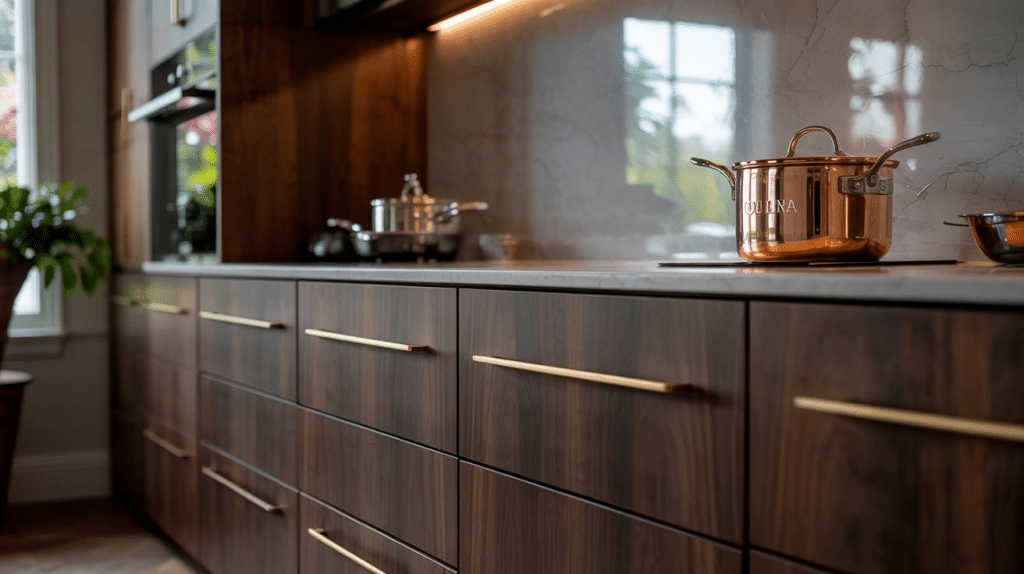
Walnut is a rich, dark hardwood that’s highly prized for its deep brown color and elegant grain patterns. It’s often used in luxury, custom cabinetry for a high-end look.
Walnut is durable, strong, and adds sophistication to any kitchen design, but it comes at a higher price point.
Cost: $10 – $20 per square foot
Best Suited For:
Luxury custom cabinetry, high-end kitchen designs, and homeowners looking for a rich, dark wood.
| Pros | Cons |
|---|---|
| Rich, dark color that deepens over time | Expensive compared to other hardwoods |
| Strong and durable | Heavy, which can make installation harder |
| Smooth texture and elegant appearance | Can be harder to find in large quantities |
8. Ash
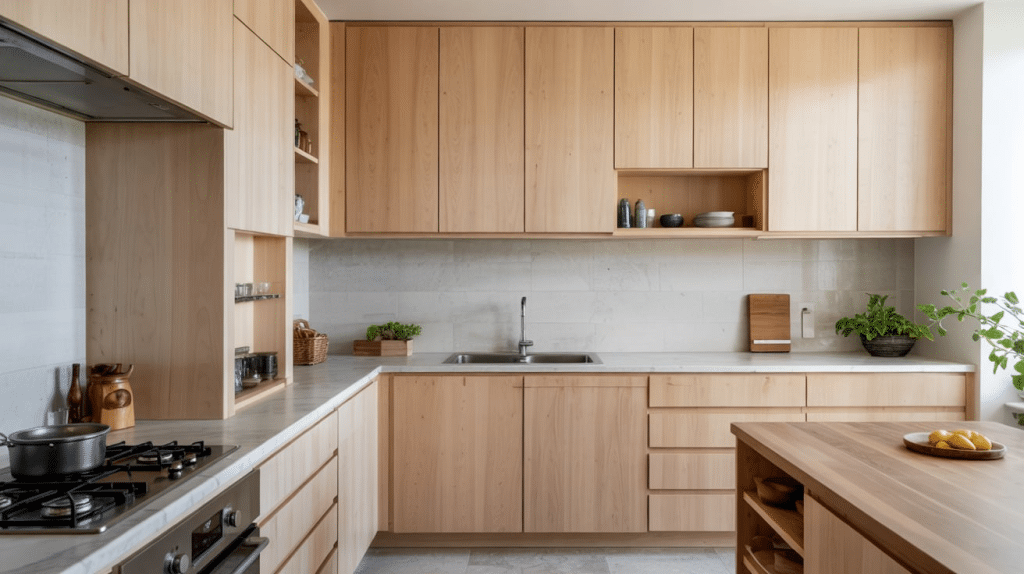
Ash is a strong hardwood that’s known for its light color and straight grain pattern. It’s less expensive than some other hardwoods but still offers good durability and strength.
Ash is popular in modern, minimalist designs, where its simple appearance adds a subtle touch of elegance.
Cost: $5 – $12 per square foot
Best Suited For:
Modern, minimalist designs and kitchens needing a light-colored, durable wood.
| Pros | Cons |
|---|---|
| Strong and durable | Less distinctive grain pattern than other woods |
| Works well with stains and finishes | Lighter color may not suit everyone |
| Ideal for modern designs | Can be more expensive than softwoods |
9. Alder
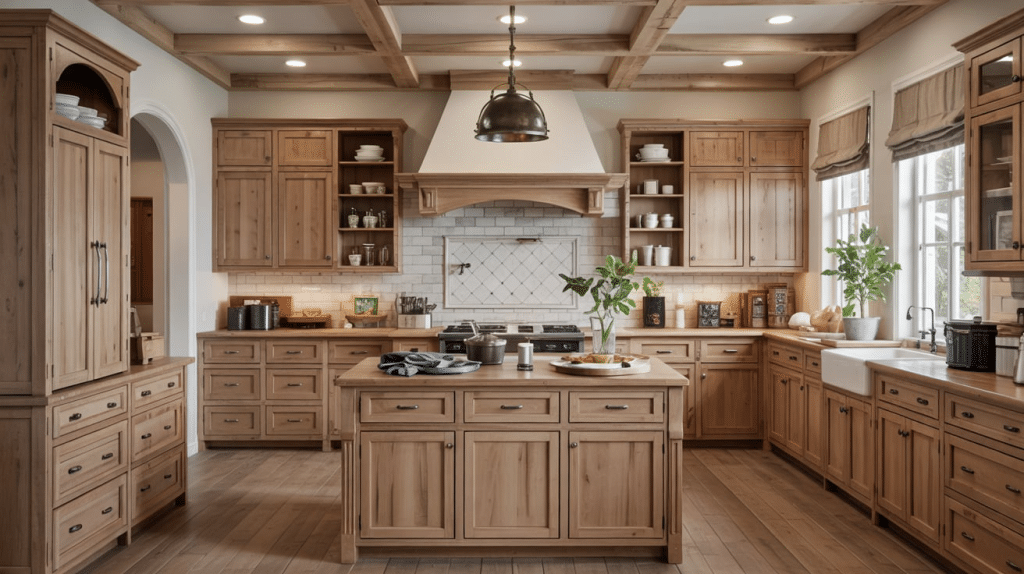
Alder is a lightweight, fine-grained hardwood that’s easy to work with and takes paint very well. It’s often used for custom cabinetry, especially in painted finishes.
Alder is affordable and gives a smooth, uniform appearance, but it’s less durable than hardwoods like oak or maple.
Cost: $4 – $8 per square foot
Best Suited For:
Custom or semi-custom painted cabinets, affordable cabinet designs, and kitchens that need a smooth, uniform finish.
| Pros | Cons |
|---|---|
| Easy to work with and install | Can dent easily due to its softness |
| Takes paint very well | Not as durable as hardwoods |
| Affordable compared to other hardwoods | Lighter color may not appeal to everyone |
10. Poplar
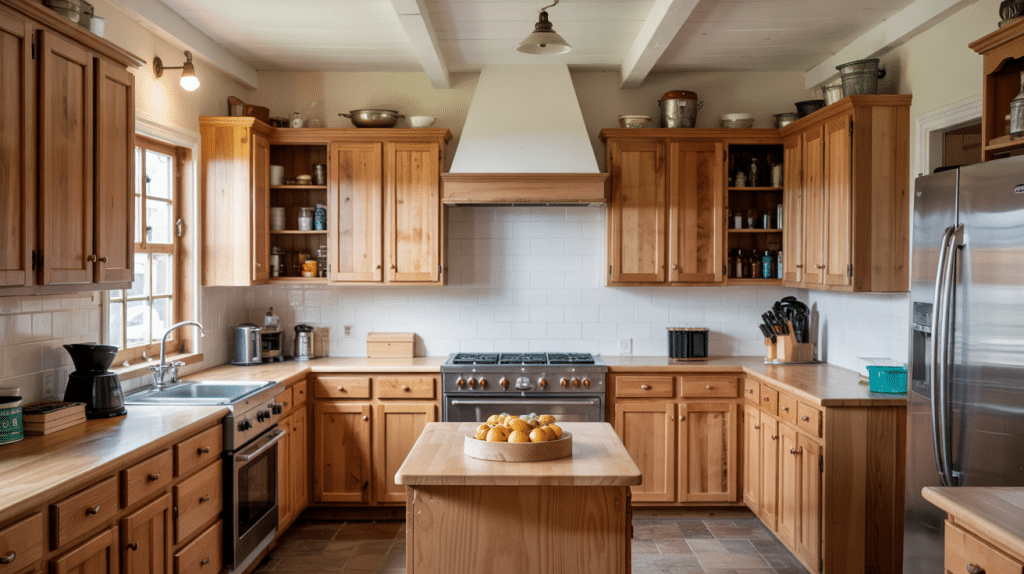
Poplar is a budget-friendly softwood that’s often used for painted cabinets. It has a light, pale color with a straight grain pattern.
Poplar is easy to work with and can be shaped and painted easily, but it’s not as durable as hardwoods, so it’s best used for decorative pieces or budget-friendly cabinetry.
Cost: $3 – $7 per square foot
Best Suited For:
Painted cabinets, budget-conscious projects, and DIY cabinetry.
| Pros | Cons |
|---|---|
| Affordable and easy to work with | Less durable than hardwoods |
| Takes paint well | Can be prone to showing imperfections |
| Light, uniform color | Soft wood that dents easily |
11. Teak
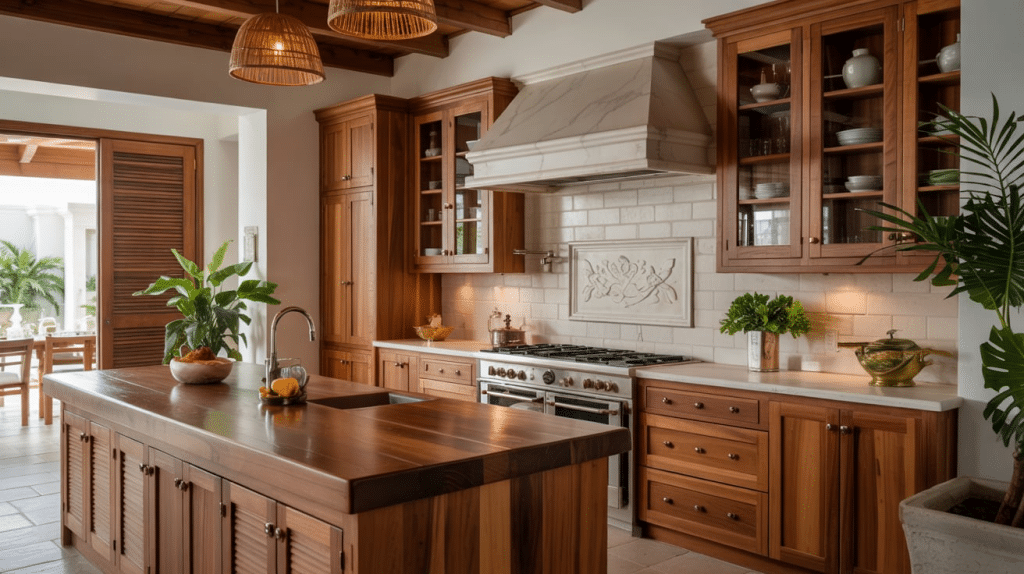
Teak is a tropical hardwood that’s known for its durability and natural water resistance. It has a rich golden-brown color and smooth texture, making it ideal for custom, high-end cabinetry.
Teak is highly resistant to moisture, which is why it’s commonly used in boats and outdoor furniture.
Cost: $15 – $30 per square foot
Best Suited For:
Luxury custom cabinetry, kitchens where moisture resistance is important, and outdoor cabinetry.
| Pros | Cons |
|---|---|
| Extremely durable and moisture-resistant | Very expensive |
| Rich, golden-brown color | Hard to work with due to density |
| Highly resistant to warping and cracking | Limited availability |
12. Mahogany
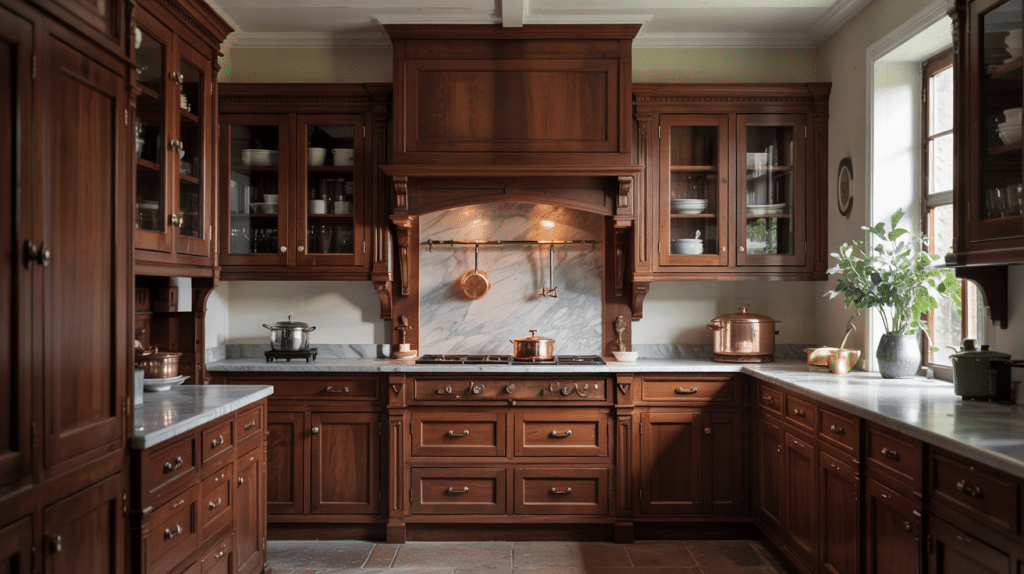
Mahogany is a luxurious hardwood with a deep reddish-brown color. It’s known for its fine grain and smooth texture, which makes it ideal for high-end custom cabinetry.
Mahogany is strong, durable, and resistant to warping, but it can be quite expensive.
Cost: $12 – $25 per square foot
Best Suited For:
Luxury kitchens, custom cabinetry, and designs where elegance and high-end appeal are key.
| Pros | Cons |
|---|---|
| Rich, deep color that deepens with age | Expensive compared to other hardwoods |
| Strong and durable | Heavy, making it harder to work with |
| Timeless, classic appearance | Prone to dents and scratches |
13. Laminate/MDF
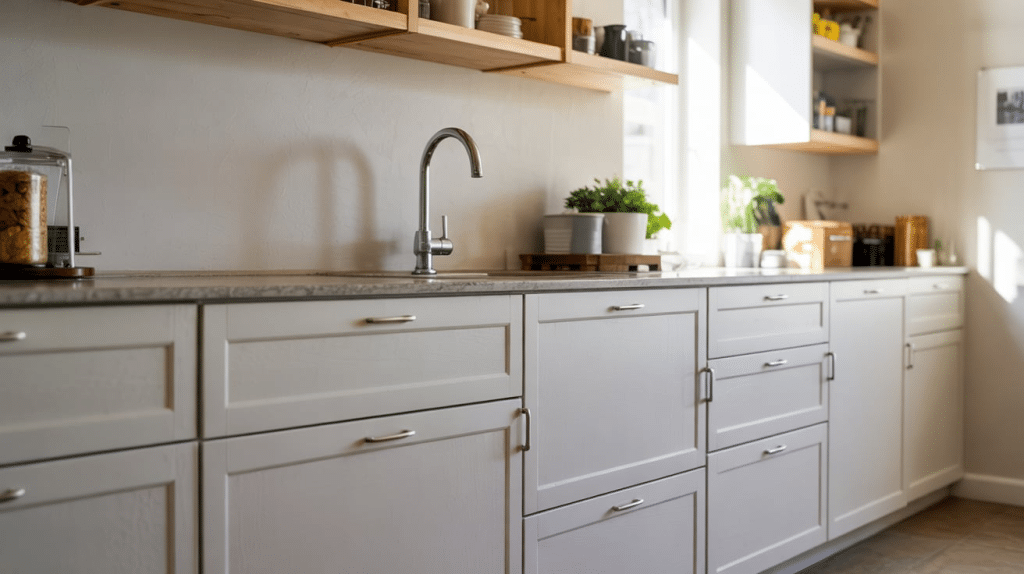
Laminate and MDF (Medium-Density Fiberboard) are synthetic options often used for budget-friendly cabinetry.
Laminate is a low-maintenance option that can mimic the look of wood, while MDF offers a smooth surface ideal for painting.
Though not as durable as solid wood, these materials are affordable and can work well in lower-cost projects.
Cost: $1 – $5 per square foot
Best Suited For:
Budget-friendly projects, painted cabinets, and areas where cost is a primary concern.
| Pros | Cons |
|---|---|
| Affordable and easy to maintain | Less durable than solid wood |
| Wide variety of finishes and styles available | Can chip or peel over time |
| Smooth, uniform finish | Not as sturdy as hardwood |
What to Consider When Choosing Cabinet Wood
Before diving into specific wood recommendations, it’s important to understand what factors you should consider when choosing the best wood for your cabinets.
Each type of wood offers its own set of benefits, so keeping these key points in mind will help you make a well-informed decision:
- Budget: Some woods are more affordable than others. If you’re working with a budget, you’ll want to focus on more cost-effective options, like pine or poplar.
- Durability: If your cabinets will experience heavy use or if you’re looking for a long-lasting investment, you should consider stronger woods like oak, maple, or hickory.
- Aesthetic Appeal: The color, grain pattern, and texture of the wood will greatly impact your kitchen or bathroom’s look. Consider if you want a classic look, something modern, or perhaps a rustic charm.
- Maintenance: Some woods require more upkeep than others. Woods like poplar and ash are relatively easy to maintain, while woods like cherry or walnut might require more care to keep them looking their best.
Considering these factors will help you select the best wood for your functional needs and personal style. Now, let’s move on to our top wood recommendations based on these qualities.
Our Top 3 Wood Recommendations Best Suited for Different Needs
Now that we’ve explored the key factors in choosing the right wood, let’s jump into the top wood recommendations based on your specific needs.
1. For Cost Effectiveness
Go for:
✓ Pine (Affordable and easy to work with).
✓ Poplar (Budget-friendly with smooth surfaces.)
✓ Birch (Low-cost hardwood with good quality.)
2. For Maximum Durability
Go for:
✓ Oak (Strong and resistant to damage.)
✓ Hickory (One of the hardest, ideal for heavy use.)
✓ Maple (Durable and resistant to wear.)
3. For Aesthetics
Go for:
✓ Maple (Smooth texture and fine grain.)
✓ Cherry (Rich color that deepens over time.)
✓ Walnut (Luxurious dark wood with elegant grain.)
4. Easy to Maintain
Go for:
✓ Poplar (Smooth and resistant to dents.)
✓ Ash (Light grain, easy to clean.)
✓ Alder (Softwood, easy to maintain.)
Conclusion
Choosing the perfect wood for your kitchen cabinets requires balancing practical considerations with personal style.
Remember that cabinet wood is an investment you’ll live with daily for many years. Consider not just today’s trends but the long-term appeal of your selection.
Factor in your household’s lifestyle – a home with young children might benefit from more durable options, while a rarely-used space might allow for woods chosen primarily for their visual appeal.
Take time to examine samples in your actual kitchen space, observing how different lighting affects their appearance throughout the day.
Thank you for sticking with us to the end! If you liked our content or have any suggestions, share them below in the comment section!

